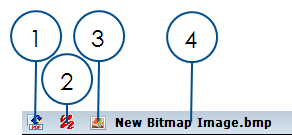 To view a document:
To view a document:Meridian Enterprise includes the AutoVue viewer developed by Oracle, Inc. for viewing documents. It is the easiest way to view your documents. You can view documents in AutoVue without the documentʹs native application installed. The viewer pane displays buttons in a toolbar that you can use to view documents in various ways and inspect them. Depending on your security permissions, you may also be able to draft print or redline documents. Regardless of what you do in the viewer pane, it will not change the document—all viewer actions are either temporary or are saved elsewhere.
Three-dimensional viewing is available from BlueCielo ECM Solutions as an extra cost option. By default, Meridian Enterprise uses the AutoVue version that can be installed as described in BlueCielo Meridian Enterprise Administrator's Guide.
All documentation for AutoVue products is available in the Meridian Enterprise distribution package and at the Oracle website. This includes the Oracle AutoVue Userʹs Manual in several languages and a Supported File Formats document that lists the supported file formats.
To install a viewer for a file format that is not supported by AutoVue, see Installing third-party viewers.To use a different viewer for a particular file format, see Changing viewers.
 To view a document:
To view a document:
Click the document name in any navigation view.
OR
In the view bar, click the View Document icon  .
.
OR
On the Document page, click the thumbnail image.
OR
On the Document shortcut menu, click Show Document.
The viewer page appears in the document pane.
 To view a document:
To view a document:
If the Viewer pane is not visible, click the Show or Hide viewer toolbutton  or double-click the thumbnail image. The document appears in the viewer pane.
or double-click the thumbnail image. The document appears in the viewer pane.
OR
The viewer info bar is shown in the following figure. It displays information about the document that is shown. The icons on the info bar are described in the following table.

| Number | Description |
|---|---|
| 1 | Native/rendition toggle – Click to toggle the viewer between showing the native file and the rendition if it exists. |
| 2 | Redlines icon – Hover the pointer over the icon to see whether the native file or the rendition or both files have redlines. |
| 3 | File icon |
| 4 | Filename |